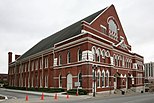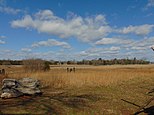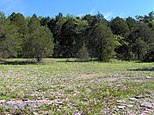Middle Tennessee | |
|---|---|
|
Images, from top down, left to right: Skyline of Nashville, the Tennessee State Capitol, the Ryman Auditorium, Stones River National Battlefield in Murfreesboro, Vanderbilt University, Fall Creek Falls, Cedars of Lebanon State Park | |
| Nickname(s): Middle TN, Middle Tenn. | |
 The counties of Tennessee highlighted in red that are designated part of Middle Tennessee. | |
| Country | |
| State | |
| Largest city | Nashville |
| Area | |
| • Land | 44,054.2 km2 (17,009.41 sq mi) |
| Population (2020) | 2,883,086 |
| • Density | 65.44/km2 (169.50/sq mi) |
| Demonym | Middle Tennessean |
Middle Tennessee is one of the three Grand Divisions of Tennessee that composes roughly the central portion of the state. It is delineated according to state law as 41 of the state's 95 counties.[1] Middle Tennessee contains the state's capital and largest city, Nashville, as well as Clarksville, the state's fifth largest city, and Murfreesboro, the state's sixth largest city and largest suburb of Nashville. The Nashville metropolitan area, located entirely within the region, is the most populous metropolitan area in the state, and the Clarksville metropolitan area is the state's sixth most populous. Middle Tennessee is both the largest, in terms of land area, and the most populous of the state's three Grand Divisions.
Geographically, Middle Tennessee is composed of the Highland Rim, which completely surrounds the Nashville Basin. The Cumberland Plateau is located in the eastern part of the region. Culturally, Middle Tennessee is considered part of the Upland South.[2] Commodity crops such as cotton and tobacco were cultivated by migrant settlers in the region in the antebellum era, who were largely dependent on the labor of enslaved African Americans. In addition, planters bred and trained livestock, such as the world-famous Tennessee Walking Horse, which was developed as a breed in the region during this time.
Middle Tennessee was a crucial region during the American Civil War. Tennessee was occupied by Federal troops from 1862 through the end of the war. Many battles and campaigns were waged by Confederates in this region, especially in efforts to control the major rivers. Confederate General Nathan Bedford Forrest conducted extensive raids through this area, destroying many Union assets in the 1864 Battle of Johnsonville. The bloodiest major battle of the American Civil War by the proportion of engaged soldiers who became casualties, the Battle of Stones River, was also fought here.
In the 20th century, the Grand Ole Opry was established in Nashville, enhancing the city as the home of country music. Since the early 1970s, the region has been transformed by the entry of many new economic sectors, including automotive manufacturing, healthcare, finance, technology, tourism, and professional services. Both the Nashville and Clarksville metropolitan areas are among the fastest-growing regions in the nation.
- ^ "Tennessee Blue Book 2015-2016" (PDF). sos.tn.gov. Nashville: Tennessee Secretary of State. 2015. p. 639. Retrieved June 5, 2021.
- ^ Jordan-Bychkov, Terry G. (2003). The Upland South: The Making of an American Folk Region and Landscape. Center for American Places. p. 9. ISBN 9781930066083. Retrieved June 13, 2021 – via Google Books.







